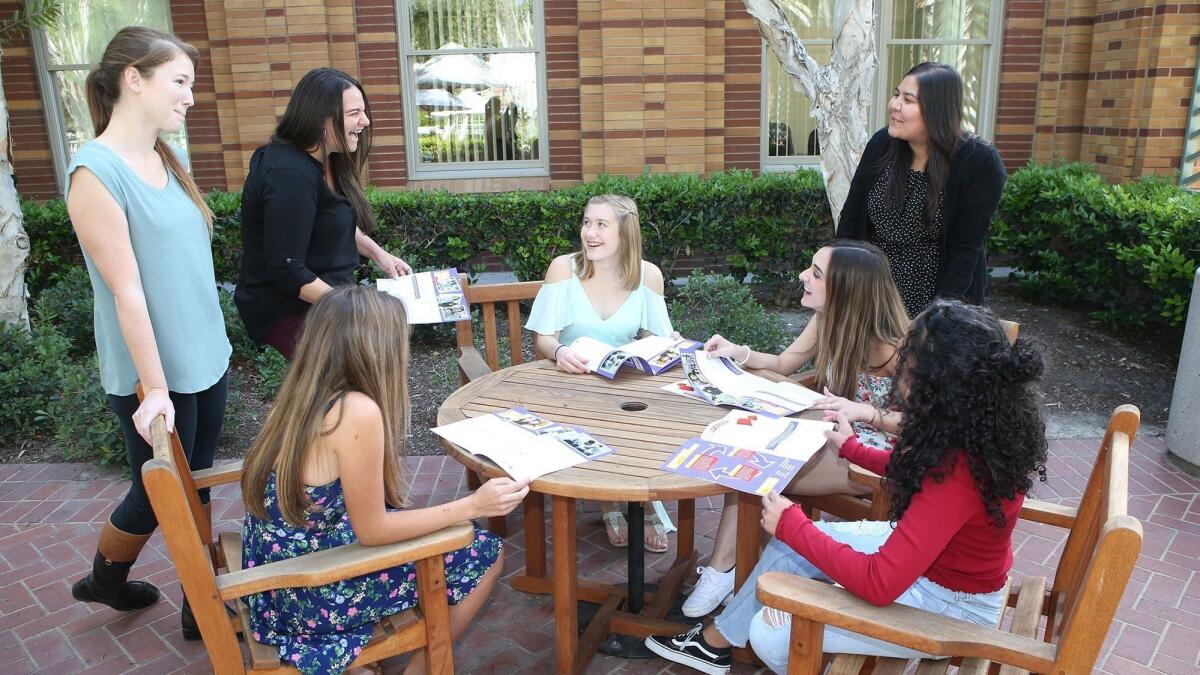69% of O.C. teens experience some form of dating violence, a Chapman University study finds

- Share via
More than two-thirds of Orange County teenagers experience some kind of dating abuse, according to a recent study by Chapman University researchers.
The study was completed for Laura’s House, a Ladera Ranch-based nonprofit that provides domestic violence-related services to local residents.
Jennifer Ponce, prevention education manager of Laura’s House, said the nonprofit hasn’t been involved with a wide-ranging study like this before, but the group wanted to make sure it had a grasp on the scope of teen dating violence in the county.
Ponce said the group’s employees were noticing that teen dating violence appeared — at least anecdotally — to be pervasive.
In particular, the nonprofit wanted to know the full extent of teen dating violence, which, in the group’s definition, includes psychological, emotional and cyber abuse.
Michelle Miller-Day, a Chapman University communication studies professor and co-author of the study, said that before their research, there were very few studies that looked at teen dating violence with the inclusion of those forms of abuse. The majority of studies generally define violence as physical or sexual.
Chapman University assistant professor of communication studies Sam Dorros also co-authored the study.
Ponce said Laura’s House used a 2008 study by Haven, an Oakland County, Mich.-based group that provides services to victims of domestic violence and sexual assault. Titled “Tween and Teen Dating Violence and Abuse Study,” it states that one in three teens were in abusive or unhealthy relationships, and includes verbal aggression as part of its definition.
In comparing that study with Chapman’s research, teen dating violence in Orange County is more than twice the national average.
Laura’s House received the completed study in April. It took about two years to compile.
Study participants were taken from a random selection of 1,530 Orange County residents. Some requirements were that individuals had to have attended an O.C. high school and be aged 18 to 21.
Miller-Day said high school kids could not be surveyed due to ethical reasons, so researchers used an age range just after that period so the respondents’ memories would be as fresh as possible.
Out of the random selection, 270 had attended a high school in the county. Of that number, 72% were women and 28% men.
That pool of respondents was asked about acceptance of dating violence. Researchers then narrowed the group down to 206 based on whether the subjects had dated in high school or not.
Findings showed that 69% of the subjects who attended Orange County high schools reported some kind of dating violence during their teenage years. Teen dating violence tended to begin at 15½ years old, but could start as young as age 11.
In breaking down the percentages based on the types of reported abuse, 34.5% reported at least one form of physical aggression (one or more times); 33.5% reported at least one form of sexual aggression (one or more times); 72.3% reported at least one form of psychological or emotional aggression (one or more times); 45.1% reported at least one form of cyber abuse (one or more times) and 44.2% reported being stalked in person or with technology (one or more times).
Psychological and emotional abuse included insults, manipulation, and feeling ignored, among others. Some examples of cyber abuse included looking at texts without permission, unwanted sexting or being pressured to send explicit images.
Miller-Day said she couldn’t speculate as to why teen dating violence is so pronounced in Orange County. She pointed out that when the definition is expanded to include psychological aggression, a lot more people will be included.
“However, you don’t want to lessen emotional and psychological impacts; those can leave scars that last longer than physical abuse,” Miller-Day said.
Ponce said findings from the study will enable Laura’s House to better combat teen dating violence in the county.
“I think this study will open a lot of doors for us,” Ponce said. “We will better be able to have this conversation and develop relationships with our school districts, colleges and universities. If we stop the cycle while these kids are young, then they won’t carry these practices into adulthood.”
Twitter:@benbrazilpilot
All the latest on Orange County from Orange County.
Get our free TimesOC newsletter.
You may occasionally receive promotional content from the Daily Pilot.




